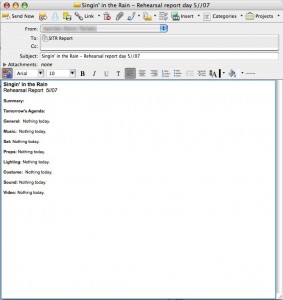I wasn’t the only one who thought my new Macbook Pro was the most important thing to happen at the Reagle Players yesterday. We have quite a few Mac users among the creative team, cast and crew, and many people were very excited to come back from dinner and see my new purchase. I had just enough time to drive up to Burlington, buy it, swing through Burger King and get back, so I didn’t have any time to start playing with it. In fact I didn’t even open the box until the first break. But then much oooing and ahhhing commenced.
I did basically one thing with it during the entire evening at the theatre, which was to set it up to use my Treo as a modem, and then download a small app to check the LCD for stuck pixels. It’s one of my bigger fears in life to spend lots of money on some wonderful computing device and find it’s got a bad pixel that I’ll have to stare at for years to come. I watched the white screen carefully as it booted up for the first time, looking for any signs of uneven backlighting, bad pixels, or other display problems. I am happy to report that this machine passed the LCD test with flying colors.
But anyway, in the midst of this important event, in the background we continued trying to put on a show. Last night we did a work-through of Act I, which was very exciting. It wasn’t quite a run, but moved fairly quickly. We were also able to have rehearsal on stage, which was very helpful for everyone. It’s definitely starting to look like a show, and it was the first time that the ensemble got to see a lot of the principals’ scenes and musical numbers, so it was kind of like having a real audience. “Good Mornin'” brought the house down.
As Singin’ in the Rain comes closer to completion, I was also greeted by this sight as I pulled into the parking lot before rehearsal:
The set of King and I under construction and being painted by the talented Matt and Jamie. A lot of Reagle’s sets are rented, or purchased from other renters, but this one is being built and stored in the back warehouse. A lot of it was already constructed when I arrived for the summer, and this week they have started painting.







